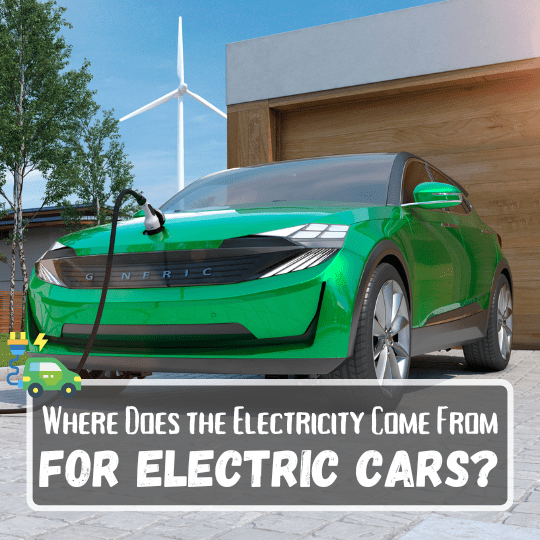
The automobile industry is investing over $1 trillion to shift from combustion engines to the electric vehicle (EV) market. Big brands that were once reluctant are now on board. In some places, they’re taking this further—Hyundai now sells only electric cars in Norway as of January 2023. But what’s going to power them all?
Yes, electricity. But it’s not as simple as that. Despite what you might think, electricity isn’t always “clean” power (produced by renewable resources). Depending on where you are in the world, your electricity could come from coal, wind, or even nuclear energy.
In 2021 (the most recent year’s overview we have), the share of global electricity from clean power was 38%. But in the first half of 2022, renewables met all growth in global electricity demand.
The future looks bright for EVs powered by renewable electricity. That’s if global governments invest a ton of cash in infrastructure (like convenient and affordable charging points) to make them accessible for everyone.
Key Takeaways:
- The share of fossil fuels in the global energy (heat and electricity) mix has been 80% for decades. According to Mckinsey’s calculations, the energy mix will rapidly shift towards power, synfuels, and hydrogen (representing 32% of the global energy mix by 2035 and 50% by 2050). This is where the electricity for cars currently comes from.
- Wind and solar (the fastest-growing electricity sources) reached a record 10% of global electricity in 2021. All clean power provided 38% of supply.
- By 2029, electric vehicles could make up ⅓ of the North American market and around 26% of vehicles produced worldwide.
- Renewable power generation is growing faster than demand (more than 10% in 2022) and replacing fossil fuels.
- The main uncertainties affecting 2023 forecasts (and further) for electricity demand and generation mix are due to fossil fuel prices and economic growth.
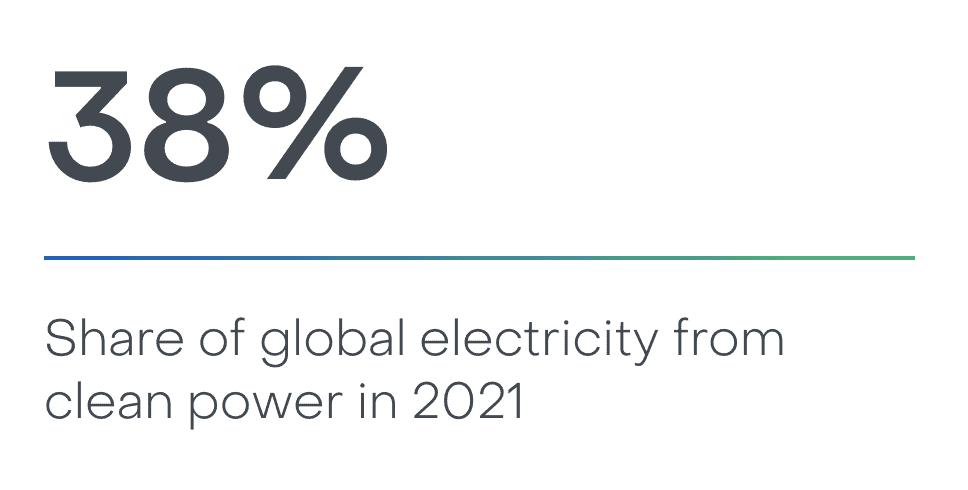
Image credit: Ember
How Do Electric Cars Work?
Electric cars use electricity from their local grid by plugging into charging stations. This energy is stored in rechargeable batteries which power a motor.
https://www.youtube.com/watch?v=GHGXy_sjbgQ&ab_channel=TechVision
EVs can accelerate faster than traditional ICE (internal combustion engine) vehicles, making them safer when you need a burst of speed to avoid a collision or to get out onto a fast-moving highway.
Electric cars have 90% fewer moving parts than an ICE alternative. Here’s a breakdown of the six main elements they need to operate:
- Electric motor/engine: AC (alternating current) motors are most common and known for their increased power output and efficiency. DC (direct current) motors are better for speed control and their range of output.
- Inverter: Converts DC electricity into AC to allow the car to operate smoothly from not moving to driving down the highway.
- Battery pack: Stores the electricity required to power the car. The higher the kW (a kW is 1,000 watts) of the battery, the longer the range.
- Onboard battery charger: Most EVs have a built-in battery charger for level 1 or level 2 charging (more on that soon).
- Battery management system: Manages the current flow to protect the battery and extend its life.
- Charging port: Where you plug into an EV charging point to recharge your battery.
With ICE vehicles, you fill up the tank with gas and you’re good to go. EVs need to be charged before they can move. But all charging stations aren’t made equal.
There are three levels of stations in the US to choose from—level 1 (the slowest) up to level 3 (the fastest).
| Level 1 | Level 2 | Level 3 |
| 120-volt wall plugs | 240 volts | 480 volts |
| Useful for overnight charging in private homes | Overnight charging at home (with the right outlet) or hotel locations | Delivers the most power – 50 kilowatts on average |
| An 8-hour charge adds 40 miles of range | Output is anywhere from 10-25kW | Charges an EV battery to about 80% in 30 minutes |
| Full charge can take 20 hours or more | Full charge in around 8 hours | Tesla’s Superchargers can offer even more power |
Where Will the Electricity Come From for Electric Cars?
In a nutshell, the future electricity source for electric cars is currently unknown. Could they be mostly powered by renewables? Studies suggest yes. However, coal and gas have also bounced back over the past few years.
According to the IEA, the main uncertainties affecting 2023 forecasts for electricity demand and generation mix are due to fossil fuel prices and economic growth. They expect global electricity demand growth in 2023 to be similar to 2022’s. Strong renewables growth of 8% and nuclear power recovery could override some of the effects of gas and coal power—resulting in the electricity sector’s CO2 emissions declining by 1%.
Electricity isn’t just used to charge and power EVs. The manufacturing process needs a lot of energy input too. So, what’s going to be powering it in years to come? It’s important to look at where we are now, so we can determine where the electricity is likely to come from for electric cars in future.
According to Mckinsey’s calculations, the energy mix (heating and electricity) will rapidly shift towards power, synfuels, and hydrogen (representing 32% of the global energy mix by 2035 and 50% by 2050).
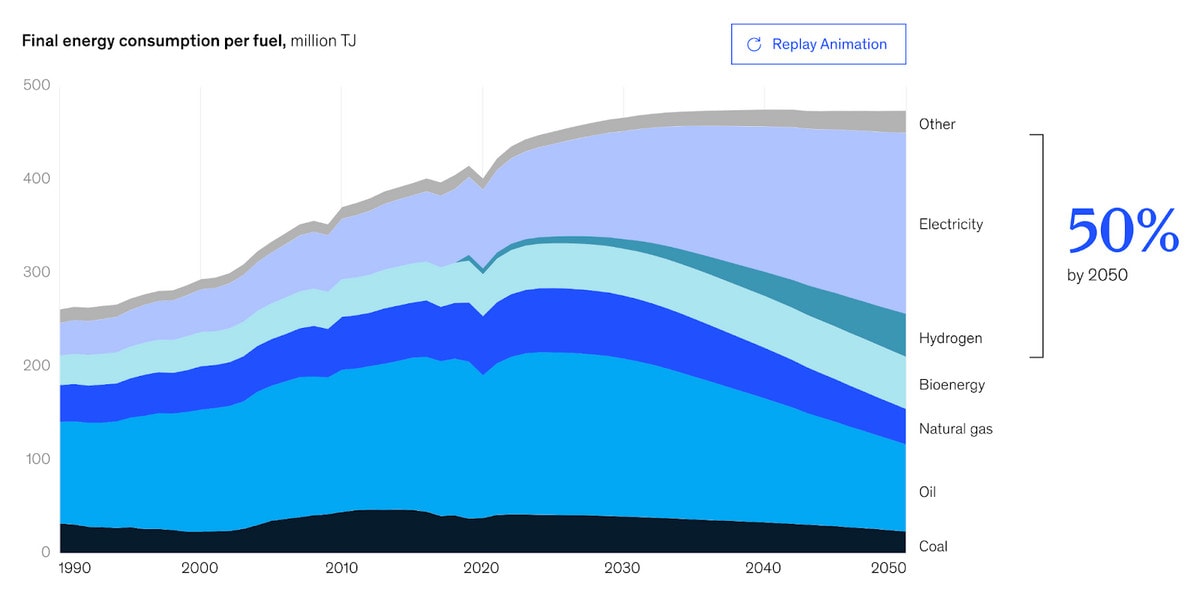
Image credit: Mckinsey
Renewables are growing faster than demand and replacing fossil fuels. Strong capacity additions are helping global renewable power generation towards growth of more than 10% in 2022.
Solar PV (photovoltaic) and wind led to an increase in global renewable electricity generation (up to October 2022) of more than 700 terawatt-hours—a unit of energy equal to outputting one trillion watts for one hour. This was the largest annual rise on record. Without this increase, global CO2 emissions would be more than 600 million tonnes higher this year.
Related Reading: Are Solar Panels Good for the Environment?
The main issue with solar power sources is that they aren’t reliable when the sun sets. Solar production doesn’t match up with the times of peak energy demand in a problem visualized as the “duck curve.”

Renewable generation is projected to reach 80–90% of the global energy mix by 2050. Global build-out rates for solar and wind will grow by a factor of five and eight, respectively. But to be successful, we need better storage capacity and alternatives for any downtime to ensure stability.
While electricity generation from both wind and solar PV grew far more than any other source last year, coal is expected to be the next largest due to soaring natural gas prices. Global CO2 emissions from coal-fired power generation are set to have grown by more than 200 million tonnes (2%) in 2022, led by increases in Asia.
The electricity sector accounted for 59% of all the coal used globally in 2021. Plus, 34% of natural gas, 4% of oil, 52% of all renewables and nearly 100% of nuclear power. It also made up over ⅓ of all energy-related CO2 emissions in 2021.
The Expansion of Electric Vehicles in the Global Market
Despite the current energy crisis, global CO2 emissions from fossil fuel combustion are expected to grow by just under 1% this year due to a strong expansion of renewable energy technologies and electric vehicles. If it weren’t for major deployments of these around the world, the rise in emissions would be much larger—more than tripling to almost 1 billion tonnes.
Electric vehicles could account for ⅓ of the North American market by 2029 and around 26% of vehicles produced worldwide. But it’s down to governments to increase subsidies and minimize barriers if there’s to be widespread adoption.
The global EV market is expected to grow at 16.4% CAGR (compound annual growth rate) from 2022 to 2029. It is expected to reach above $628 billion by 2029 from $160 billion in 2020.

Image credit: Exactitude Consultancy
Electrifying transport naturally boosts electricity demand. EVs are projected to account for about 4% of total final electricity demand by 2030. At 1,100 terawatt-hours (TWh), this would be equivalent to double today’s total electricity use in Brazil.
Green hydrogen could become an important storage mechanism for power production. New technologies like vehicle-to-grid and long-duration energy storage could play a key role if they evolve and can be cost-effective.
Around half of the emissions from battery production come from the electricity used in manufacturing and assembling them. Producing in regions with relatively low-carbon electricity or renewable energy-powered factories (like Tesla) can substantially reduce battery emissions.
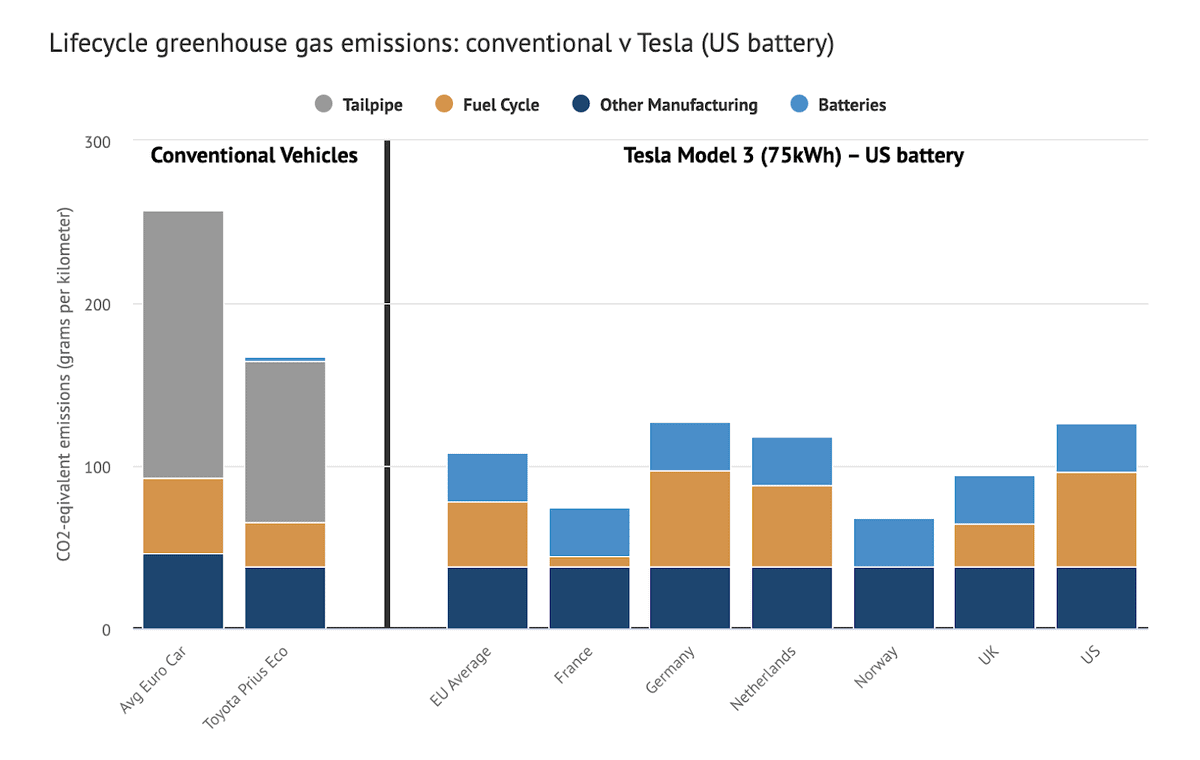
Image credit: Carbon Brief
As countries decarbonize their electricity generation to meet their climate targets, driving and manufacturing emissions will fall for existing and new EVs.
The electricity mix that EVs will rely on in future depends on a lot of varying factors in the coming years. It’s not possible to say what it will be because it’s constantly changing. If it’s to be from renewable resources, we’re going to have to see big changes made by governments and corporations globally.
What Is the Current State of the Electric Vehicle Market?
An EV’s production generates an almost 80% higher emissions intensity compared with an ICE car. (Mostly because of the battery and higher share of aluminum.)
In the European Union, achieving 75% EV sales by 2030 will implicate the entire value chain and ecosystem. If this is to work, the industry has to decarbonize the full lifecycle of vehicles to hit a net-zero target.
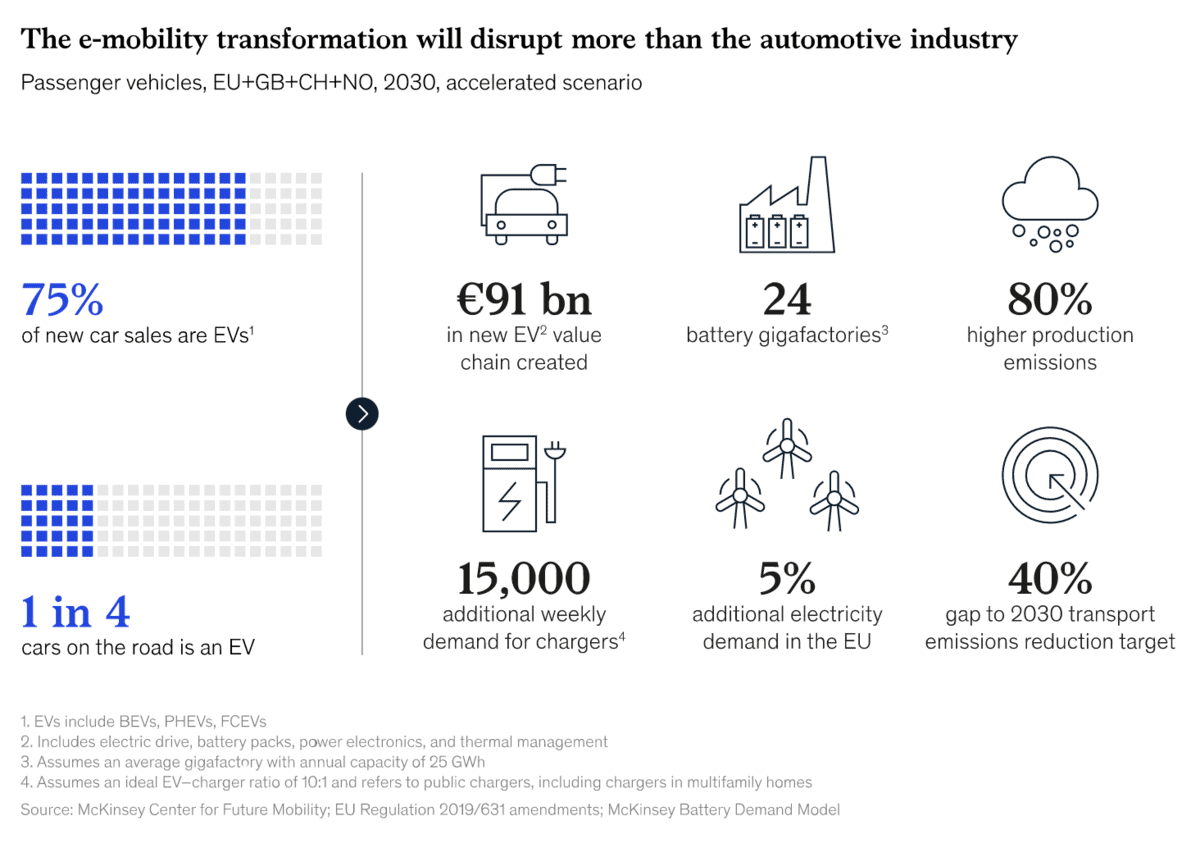
The success of electric vehicles is being driven by multiple factors—the main being sustained policy support. Public spending on subsidies and incentives for EVs nearly doubled in 2021 to almost $30 billion.
Sales of electric cars (including fully electric and plug-in hybrids) also doubled in 2021 to a new record of 6.6 million. That means more cars were sold each week than in the whole of 2012. The number of electric cars on the world’s roads by the end of the year was about 16.5 million—3x the amount in 2018.
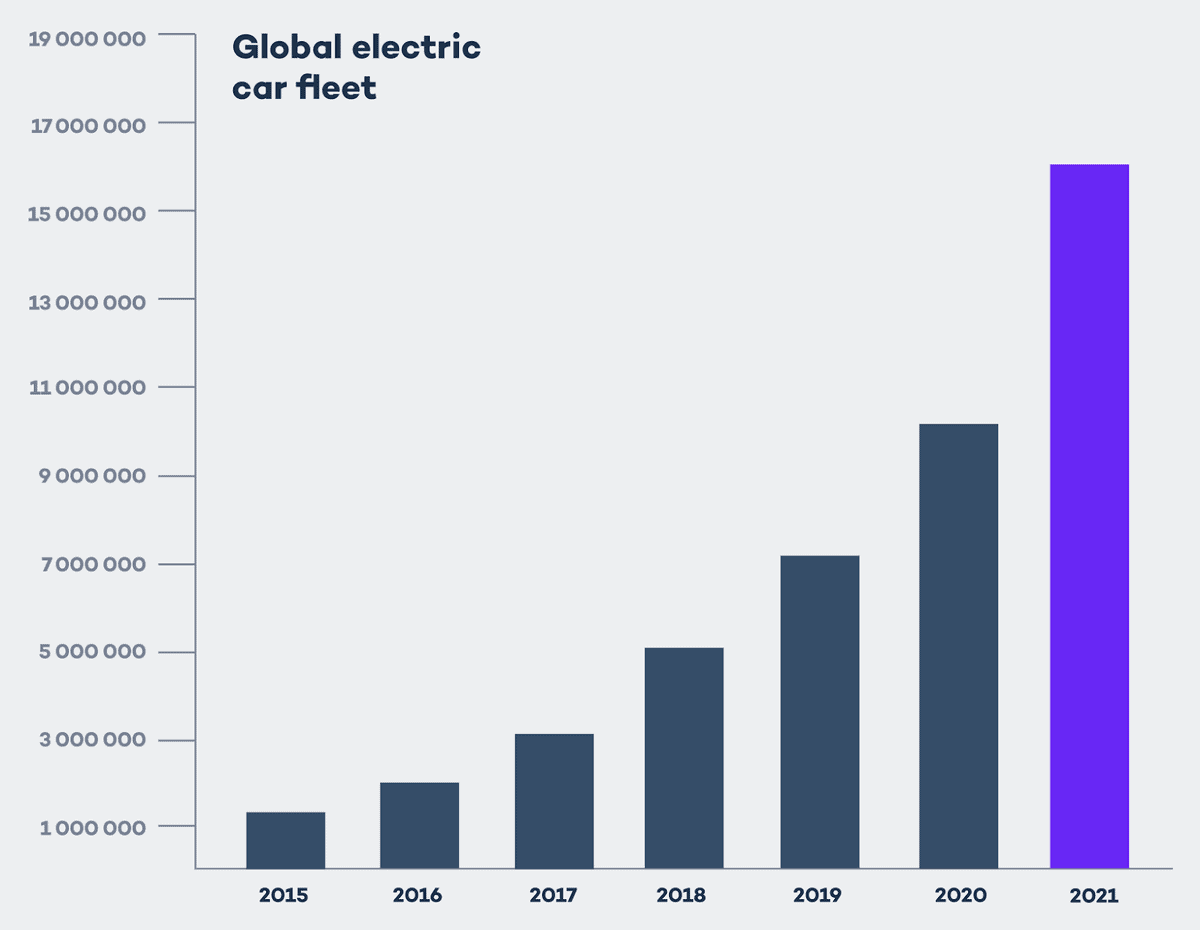
These sales kept rising strongly into 2022, with 2 million electric cars sold globally in the first quarter (up by three-quarters from the same timeframe a year earlier.)
In both the US and Europe, EVs can substantially reduce lifecycle greenhouse gas emissions compared to the average ICE vehicle. As electricity generation becomes less carbon-intensive, EVs will become preferable in pretty much all cases.
“There are fundamental limitations on how efficient petrol and diesel vehicles can become, whereas low-carbon electricity and increased battery manufacturing efficiency can cut much of the manufacturing emissions and nearly all electricity use emissions from EVs”, says Carbon Brief.
“If countries do not replace coal and, to a lesser extent, gas, then electric vehicles will still remain far from being ‘zero emissions’.”
What Does the Future Look Like for Electric Cars?
STEPS and APS are scenarios created by the International Energy Agency.
| APS (Announced Pledges Scenario) | STEPS (Stated Policies Scenario) |
| APS aims to show to what extent announced ambitions and targets are on the way to deliver reductions required to achieve net zero emissions by 2050. | STEPS is a more conservative benchmark for the future and doesn’t take for granted that governments will reach all announced goals. |
Low-emission sources of electricity (led by renewables) are projected to overtake fossil fuels by 2030 in both STEPS and APS. This will end decades of growth for coal.

Power consumption is projected to triple by 2050. Electrification is one of the lowest-cost options for decarbonization and the easiest to implement in most sectors.
Around 80-90% of today’s typical material emissions can be eliminated with 2030 technologies. This can happen by decarbonizing the raw material refining and manufacturing processes using renewable electricity.
A switch in electricity resources can happen, but shifting from today’s manufacturing processes to routes that avoid CO2e (carbon dioxide equivalent) emissions altogether will need significant investments in plants and equipment. Long-term commitments in the next decade between suppliers and buyers could help overcome this obstacle.
Another way to reduce CO2e emissions from ICE vehicles can be increasing the share of bio and e-fuels with a low carbon footprint. However, most of the supply will be going towards decarbonizing marine, aviation and commercial road transport (as limited zero-emissions alternatives exist for each today).
The costs of using sustainable fuels are projected to be higher in the long term. But using 100% renewable diesel (like HVO) can achieve comparable lifecycle greenhouse gas (GHG) reduction to EVs. This will contribute to faster decarbonization of existing fleets in the short term.

Image credit: sennder
Even if EVs managed to account for ~75% of total vehicle sales by 2030, reaching regulatory GHG reduction targets for transportation could still need a significant contribution from sustainable fuels.
Renewable Resources for Electric Car Power Generation
According to Russell Hensley, co-leader of the McKinsey Center for Future Mobility in the Americas, “Toward the end of the decade, about half of the new vehicles sold in the US…will likely be powered by an electric motor and battery.”
If this is going to be sustainable, the amount that’s reused and recycled from each car needs to be maximized. But this can only happen if the infrastructure is there to support it. Where the electricity will come from to power them remains to be seen.
As consumers, we can only put pressure on the government and other huge corporations to make sure they continue to put funding into renewable resources for power generation. Otherwise, it’s out of our hands.
Read Next:




